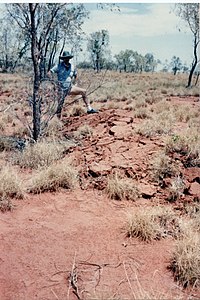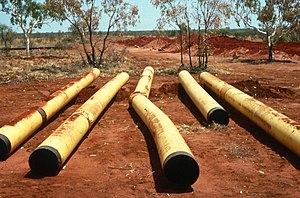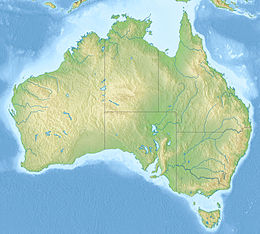 Surface rupture caused by the earthquakes | |
| UTC time | 1988-01-22 00:36:00 |
|---|---|
| 1988-01-22 03:57:28 | |
| 1988-01-22 12:05:00 | |
| ISC event | 448554 |
| 448569 | |
| 448602 | |
| USGS- ANSS | ComCat |
| ComCat | |
| ComCat | |
| Local date | 22 January 1988 |
| Local time | 10:06 |
| 13:57 | |
| 22:05 | |
| Duration | 45 seconds (mainshock) [1] |
| Magnitude | 6.2 Mw [2] |
| 6.3 Mw [2] | |
| 6.6 Mw [2] | |
| Epicenter | 19°49′S 133°53′E / 19.81°S 133.89°E |
| Fault | Lake Surprise and Kunayungku faults |
| Type | Thrust [3] |
| Areas affected | Northern Territory, Australia |
| Total damage | $1 million [3] |
| Max. intensity | MMI IX (Violent) [4] |
| Aftershocks | More than 15,000, the biggest being mb 5.8 [5] |
| Casualties | None |
On 22 January 1988, a sequence of destructive earthquakes measuring 6.2, 6.3, and 6.6 struck southwest of Tennant Creek, Australia which was felt as far north as Darwin and in other regions of the country. The largest event of the sequence was the largest earthquake ever recorded in mainland Australia since records began in 1800. [6] An intensity of IX (Violent) was observed. Despite the large magnitude of the earthquakes and a close proximity to a town, in a country where earthquakes of this size are not common, damages were limited. Thousands of aftershocks were reported and felt across Northern Territory. [6]
Tectonic setting
The continent of Australia borders some very seismically active regions, as such as the boundary between the Pacific and the Australian Plate where both plates collide, which runs from the island of New Guinea all the way to New Zealand. On the south and west sides of it are moderately active mid-ocean ridges which run through the Indian Ocean. However, the continent does not border these and is intraplate therefore occurrences of large earthquakes are rather rare. Despite the low seismicity, most large earthquakes which occur within Australia are scientifically significant. A few earthquakes of magnitude 5 occur yearly in average, and smaller, local earthquakes can occur daily and be detected by seismograms. [7]
These big earthquakes near Tennant Creek occurred in the Proterozoic North Australian Craton, approximately 1500 km further south than the nearest plate boundary, therefore these events are referred to as intraplate earthquakes. The area where the quakes struck had no history of any earthquake before 1986 compared to the other seismic zones that have had bigger quakes which were seismically active beforehand. [8]
The Tennant Creek fault zone which includes the Kunayungku and Lake Surprise faults which were ruptured, is located on the border between a Palaeozoic basin and an early Proterozoic Tennant Creek inlier which is surrounded by younger rocks. Both of these areas are a part of the North Australian Craton, which has formed a single stationary block of crust for 1,700 million years. The inlier is a basement of another bigger feature and consists of a group made up of sedimentary and metasedimentary rocks which is the Warramunga group which is intruded by older granite. Cambrian sedimentary platform sequences of the Palaeozoic Wiso Basin overlaps the Tennant Creek inlier on the western side near the fault scarps located in the region forming an extensive transition zone. [8]
The focal depths of the Tennant Creek sequence ranged from 3.5 to 6.5 km, which is deeper than the thickness of the Cambrian platform near the epicenter. This proves that rather than the basin sedimentary, the Proterozoic basement controlled the nucleation of rupture. [8]
Earthquakes
The sequence created two scarps on the faults; the Lake Surprise scarp on the southern side in a boomerang shape looked from bird's eye and the Kunayungku scarp on the northern side which is shorter than Lake Surprise. On the west-northwest trending scarps, the Lake Surprise scarp was lifted as much as 2 meters compared to the northern one and a trench across the southern LS (Lake Surprise) scarp revealed a thrust plane that was dipping 20 to 30 degrees. No scarp was found when the pipelines that got damage were being surveyed. Other articles describe the aftershock zones as dipping towards the southwest at 40 to 50 degrees from the west-northwest trending ruptures. The east-northeast trending Western LS scarp did display a left lateral strike-slip motion but dip-slip was the dominant characteristic. The slip on the Western LS fault from observations in the area was thought to be facing northward, opposite to that observed on the scarps trending west-northwest. It is interpreted that the preliminary epicenters of the aftershocks are displaying a northwest dip for the Western LS fault which concludes that it is a thrust fault which also proves, along with focal mechanisms inferred from waveform data, that the focal mechanism of the 3 main shocks are thrust, oblique thrust and thrust in order. [9] [8]
Aftershocks
In the following year after the sequence, more than 15,000 aftershocks were recorded by the nearby Warramunga seismic array, with some aftershocks exceeding the magnitude 5 mark. The aftershocks include a 5.8 which occurred 8 hours after the biggest and last mainshock, a 5.5 occurring a week after and a 5.2 occurring later in the year at September 30. [5]

Impacts
As a result of the events, lengthy surface ruptures measuring up to 32 km were observed along the faults. [3]
Pipelines were heavily damaged as a result of the surface ruptures. Tennant Creek's hospital was seriously damaged. A few other homes were lightly damaged. [1] No injuries or deaths were reported and 1 million USD of damage was caused. [3]
See also
References
- ^ a b "Resource - Australian Emergency Management Knowledge Hub". Archived from the original on 5 March 2016. Retrieved 10 June 2013.
- ^ a b c ISC (2016), ISC-GEM Global Instrumental Earthquake Catalogue (1900–2012), Version 3.0, International Seismological Centre
- ^ a b c d Bowman, J. R. (14 November 1991). "The 1988 Tennant Creek, northern territory, earthquakes: A synthesis". Australian Journal of Earth Sciences. 39 (5): 651–669. doi: 10.1080/08120099208728056. Retrieved 26 August 2022.
- ^ "Significant Earthquake Information". NCEI. Retrieved 26 August 2022.
- ^ a b Bowman, J. R.; Gibson, G.; Jones, T. (20 July 1989). "Aftershocks of the 1988 January 22 Tennant Creek, Australia intraplate earthquakes; evidence for a complex thrust-fault geometry". Geophysical Journal International. 100 (1): 10. doi: 10.1111/j.1365-246X.1990.tb04570.x.
- ^ a b "Tennant Creek 1988 earthquake now Australia's biggest after Geoscience revises list". ABC News. 12 May 2016. Retrieved 26 August 2022.
- ^ Doyle, H. A.; Everingham, I. B.; Sutton, D. J. (30 July 1968). "Seismicity of the Australian continent". Journal of the Geological Society of Australia. 15 (2): 20. Bibcode: 1968AuJES..15..295D. doi: 10.1080/00167616808728700. Retrieved 26 August 2022.
- ^ a b c d Bowman, J. R. (14 November 1991). "The 1988 Tennant Creek, northern territory earthquakes: A synthesis". Australian Journal of Earth Sciences. 39 (5): 651–669. doi: 10.1080/08120099208728056. Retrieved 26 August 2022.
- ^ McCaffrey, R. (May 1989). "Teleseismic investigation of the January 22, 1988 Tennant Creek, Australia, earthquakes". Geophysical Research Letters. 16 (5): 413–416. Bibcode: 1989GeoRL..16..413M. doi: 10.1029/gl016i005p00413. Retrieved 26 August 2022.
Further reading
- Anthony J. Crone; Michael N. Machette; J. Roger Bowman (1992). "Geologic Investigations of the 1988 Tennant Creek, Australia, Earthquakes-Implications for Paleoseismicity in Stable Continental Regions" (PDF). U.S. Geological Survey. United States Government Printing Office.
External links
- The International Seismological Centre has a bibliography and/or authoritative data for this event. (First shock)
- The International Seismological Centre has a bibliography and/or authoritative data for this event. (Second shock)
- The International Seismological Centre has a bibliography and/or authoritative data for this event. (Third and strongest shock)

